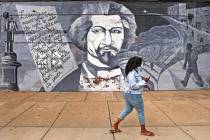‘Doing something’ can fall short as solution
After a massacre like the one at Emanuel AME Church in Charleston, S.C., our immediate reaction is to do something. Something, for politicians, means legislation. And for Democratic politicians, this means gun control.
It’s the all-purpose, go-to, knee-jerk solution. Within hours of the massacre, President Obama was lamenting the absence of progress on gun control. A particular Democratic (and media) lament was Congress’ failure to pass anything after Sandy Hook.
But the unfortunate fact is that the post-Sandy Hook legislation would have had zero effect on the events in Charleston. Its main provisions had to do with assault weapons; Dylann Roof was using a semiautomatic pistol.
You can pass any gun law you want. The 1994 assault weapons ban was allowed to expire after 10 years because, as a Justice Department study showed, it had no effect. There’s only one gun law that would make a difference: confiscation. Everything else is for show.
And in this country, confiscation is impossible. Constitutionally, because of the Second Amendment. Politically, because doing so would cause something of an insurrection. And culturally, because Americans cherish — cling to, as Obama once had it — their guns as a symbol of freedom.
You can largely ban guns in Canada, where the founding document gives the purpose of confederation as the achievement of “peace, order and good government.” Harder to disarm a nation whose founding purpose is “life, liberty and the pursuit of happiness.”
With gun control going nowhere, the psychic national need post-Charleston to nonetheless do something took a remarkable direction: banishment of the Confederate flag, starting with the one flying on the grounds of the statehouse in Columbia, then spreading like wildfire to consume Confederate flags, symbols, statues and even memorabilia everywhere — from the Alabama state capitol to eBay and Amazon.
Logically, the connection is tenuous. Yes, Roof does pose with the Confederate flag, among other symbols of racism, on his website. But does anyone imagine that if the South Carolina flag had been relegated to a museum, the massacre would not have occurred?
Politically, the murders created a unique moment. Gov. Nikki Haley was surely sincere in calling for the Confederate flag’s removal. But she also understood that the massacre had created a moment when the usual pro-Confederate flag feeling — and, surely, expressions of it — would be largely suppressed, presenting the opportunity to achieve something otherwise politically unachievable.
But there’s a deeper reason for this rush to banish Confederate symbols, to move them from the public square to the museum. The trigger was not just the massacre itself, but even more tellingly, the breathtaking display of nobility and spiritual generosity by the victims’ relatives. Within 48 hours of the murder of their loved ones, they spoke of redemption and reconciliation and even forgiveness of the killer himself. It was an astonishingly moving expression of Christian charity.
Such grace demands a response. In a fascinating dynamic, it created a feeling of moral obligation to reciprocate in some way. The flag was not material to the crime itself, but its connection to the underlying race history behind the crime suggested that its removal from the statehouse grounds — whatever the endlessly debated merits of the case — could serve as a reciprocal gesture of reconciliation.
The result was a microcosm of — and a historical lesson in — the moral force of the original civil rights movement, whose genius was to understand the effect that combating evil with good and violence with grace would have on a fundamentally decent American nation.
America was indeed moved. The result was the civil rights acts. The issue today is no longer legal equality. It is more a matter of sorting through historical memory.
The Confederate flags would ultimately have come down. That is a good thing. They are now coming down in a rush. The haste may turn out to be problematic.
We will probably overshoot, as we are wont to do, in the stampede to eliminate every relic of the Confederacy. Not every statue has to be smashed, not every memory banished. Perhaps we can learn a lesson from Arlington National Cemetery, founded by the victorious Union to bury its dead. There you will find Section 16. It contains the remains of hundreds of Confederate soldiers grouped around a modest, moving monument to their devotion to “duty as they understood it” — a gesture by the Union of soldierly respect, without any concession regarding the taintedness of their cause.
Or shall we uproot them as well?
Charles Krauthammer (letters@charleskrauthammer.com) is a Washington Post columnist.

















